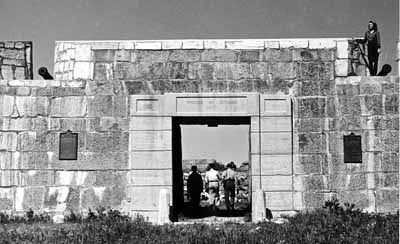Prince of Wales Fort National Historic Site of Canada
Eskimo Point, Manitoba

General view
© Parks Canada Agency / Agence Parcs Canada
Address :
Eskimo Point, Manitoba
Recognition Statute:
Historic Sites and Monuments Act (R.S.C., 1985, c. H-4)
Designation Date:
1920-01-30
Dates:
-
1731 to 1771
(Construction)
-
1731 to 1782
(Significant)
Event, Person, Organization:
-
Samuel Hearne
(Person)
-
Hudson’s Bay Company
(Organization)
Other Name(s):
-
Prince of Wales Fort
(Designation Name)
Research Report Number:
1991-033, 1994-034
DFRP Number:
13251 00
Plaque(s)
Existing plaque: On stone wall outside main entrance Eskimo Point, Manitoba
Built upon plans drawn by English military engineers to secure control of Hudson Bay for the Hudson's Bay Company and England. Construction commenced in 1733 and completed in 1771. Surrendered to and partially destroyed by a French naval force under La Pérouse in 1782. Its ruins are among the most interesting military remains on this continent.
Description of Historic Place
Prince of Wales Fort National Historic Site of Canada is a ruinous early 18th-century fur trade fortress built by the Hudson’s Bay Company. Surviving stone walls stand starkly silhouetted on the tundra along the shore of Hudson’s Bay at the mouth of the Churchill River in northern Manitoba. The designation refers to the remains of the fort on its point of land, Sloop Cove - historically the Hudson’s Bay Company’s winter harbour - and Cape Merry - a defensive battery situated on a point of land across the Churchill River opposite the fort.
Heritage Value
Prince of Wales Fort was designated a national historic site in 1920, and expanded by the addition of Sloop Cove and Cape Merry in 1933, because: it commemorates Prince of Wales Fort’s role in the 18th-century French-English rivalry for control of the territory and resources around Hudson Bay. Fundamental to this commemoration is the role of the fur trade and its participants. the ruin that is Prince of Wales Fort is of both national historic and architectural significance.
The heritage value of Prince of Wales Fort lies in its historical associations and in the physical remains of the fort and its cultural landscape. Prince of Wales Fort was built by the Hudson’s Bay Company in 1731-1771 at a time when its major shipment and supply route operated from Hudson’s Bay through Arctic waters. The fortress was constructed to be an impregnable English stronghold, and today its imposing 12 m thick walls and 40 mounted cannon still survive along with the battery, cannon and powder magazine built to safeguard it on Cape Merry. As commander of the fort, Explorer Samuel Hearne surrendered it to the French in 1782, an act that terminated Hudson’s Bay occupation and terminated Prince of Wales Fort’s utility. Parks Canada engaged in limited repair and restoration of the fortress walls in the 1935-1965 period.
Sources : Historic Sites and Monuments Board of Canada, Minutes, June 1991, November 1994; Management Plan, 2000.
Character-Defining Elements
Key elements contributing to the heritage value of this site include:
the cultural landscape of the Fort in its isolated location, the flat tundra that comprises the site of the fort and battery, the deep harbour and natural geographic contours of Sloop Cove, and the remains of buildings and evidence of activity related to the fort’s occupancy; the footprint and profile of remnants of the unique star-shaped fort and of the battery at Cape Merry; the location, dimension, and original materials of remnant fortification walls; the use of local stone in the fort’s construction and the skilled workmanship evident in fine masonry work; evidence of functional design of the fort such as its gate and entrance passage, its courtyard, its bastions, parapet walls, cobblestone paving in the courtyard, curtain walls, and the ravelin which sits outside the fort and protects the gate; archaeological remnants of buildings in the courtyard, their locations, footprints, layouts, materials; remnant cannon (including those remounted in repair and restoration) and other metalwork (such as mooring rings set in the rocks); archaeological evidence of 18th-century life at the fort; viewscapes from the fortress to the shoreline of Hudson’s Bay and the Churchill River, to the fortress, across the Churchill and to Hudson’s Bay from Cape Merry, and from Sloop Cove to the Churchill River.